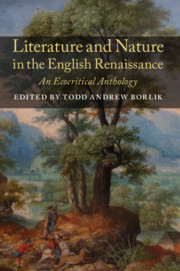Book contents
- Frontmatter
- Contents
- List of Illustrations
- Acknowledgements
- Editorial Principles: Towards the Ecocritical Editing of Renaissance Texts
- Introduction
- PART I Cosmologies
- PART II The Tangled Chain
- PART III Time and Place
- PART IV Interactions
- PART V Environmental Problems in Early Modern England
- Population
- Enclosure
- Deforestation
- The Draining of the Fens
- Pollution
- PART VI Disaster and Resilience in the Little Ice Age
- Appendix A Industrialization and Environmental Legislation in the Early Anthropocene: A Timeline
- Appendix B Further Reading: A Bibliography of Environmental Scholarship on the English Renaissance
Population
from PART V - Environmental Problems in Early Modern England
Published online by Cambridge University Press: 05 June 2019
- Frontmatter
- Contents
- List of Illustrations
- Acknowledgements
- Editorial Principles: Towards the Ecocritical Editing of Renaissance Texts
- Introduction
- PART I Cosmologies
- PART II The Tangled Chain
- PART III Time and Place
- PART IV Interactions
- PART V Environmental Problems in Early Modern England
- Population
- Enclosure
- Deforestation
- The Draining of the Fens
- Pollution
- PART VI Disaster and Resilience in the Little Ice Age
- Appendix A Industrialization and Environmental Legislation in the Early Anthropocene: A Timeline
- Appendix B Further Reading: A Bibliography of Environmental Scholarship on the English Renaissance
Summary
While the Black Death had thinned the late medieval population by a third, the numbers rose dramatically throughout the early modern era. Between the reigns of Henry VIII and Charles II the population expanded from around 2.5 million to 5.5 million (Wrigley and Scofield). As London began to feel overcrowded and food prices rose (exacerbated by dearth and the converting of farmland to pasture), some advocated colonial expansion as a safety valve for demographic pressures on England's natural resources. As a mathematician and promoter of Ralegh's Virginia colony, Thomas Harriot would have understood the appeal of this argument. But this solution prompted Harriot to formulate an even bigger question: how many humans could the earth support? Sometime after his return to England, he drew up the first known calculations of the planet's carrying capacity.
Source: BL Add. MS 6782, 31r–v.
Suppositions …
The compass of the Earth after the rate of 60 miles to a degree = 21,600 ° miles.
Ergo: The half compass = 10,300 ° miles.
The semi-diameter of the Earth = 3,437.747 ° miles
3,437.747 × 10,300 = 35,408,794.1
plano circuli quod æquat ¼ superf. terræ et aquæ. °
Ergo: 35,408,794.1 × 4 = 141,635,176.4 superf. maris et terræ. °
70,817,588.2 = superf. terræ. vel maris. °
49,987 miles square in England (ut alibi ° by Saxton's ° great map) after the rate of 60 miles to a degree, including rivers and all wastes. °
It lacketh but 13 miles of 50,000. 50,000 miles2: 5,000,000 ° persons supposed = 1 mile2: 100 persons.
70,817,588 miles2: 7,081,758,800 persons in the Earth.
[Amount of land needed to support one person]
1,000,000 paces2: 100 persons = 10,000 paces2: 1 person.
10,000 paces2 = 250,000 feet2 = 5 acres.
6 men may stand in a pace square.
Therefore 6,000,000 in 1 mile square.
7,081,758,800 × 6,000,000 = 42,490,552,800,000,000 = The number of persons that may stand on the Earth.
[31v] The issue from one man and one woman in 240 years may be more than can inhabit the whole Earth.
Supposing
1. That the first man and woman have a child every year: one year male and in other year female.
2. That the children when they are 20 years old and upward do also every year beget a child: one year male and another year female.
- Type
- Chapter
- Information
- Literature and Nature in the English RenaissanceAn Ecocritical Anthology, pp. 395 - 402Publisher: Cambridge University PressPrint publication year: 2019



